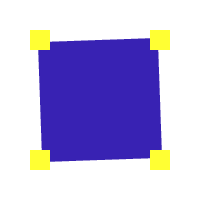
Optical illusions are testaments to the strengths of our visual systems, rather than their weaknesses, even if they do routinely trick our eyes. When presented with apparent contradictory or abstract data, our brain immediately strives to interpret the picture into a contextual scene.
With the pulsating square illusion, very little of the rotating blue square is observed when the yellow, obstructing squares are at their largest. The fact is we can only perceive the edges of the blue square through the four narrow slits created by the yellow squares. With the rotation of the blue square, its edges, as viewed through the slits, go up and down from the center. Due to the fact that the slits divide the motion of the edges into segments that are spaced far apart, the in and out motion of the edges has more perceptual salience than the rotation of the blue square.
Said in another way, since the data on the blue square’s motion is vaguely defined, our visual system focuses on the most striking features, the in and out movement along the edges. With this being their most prominent feature, the blue squares appear to pulsate.
With the yellow occluding squares shrinking, the rising distinction of the blue square’s rotation increases proportionately, and we cease to perceive the pulsating blue square.






 English
English
 Français
Français


